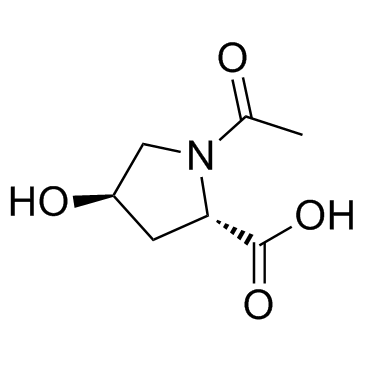Oxaceprol, an atypical inhibitor of inflammation, reduces leukocyte adherence in mouse antigen-induced arthritis.
A Veihelmann, A Hofbauer, H J Refior, K Messmer
Index: Acta Orthop. Scand. 72(3) , 293-8, (2001)
Full Text: HTML
Abstract
Oxaceprol (N-acetyl-L-hydroxyproline), an atypical inhibitor of inflammation, is an established drug forjoint disease without serious side-effects. Recent studies have emphasized that oxaceprol has an effect on the microcirculation. Since the exact mechanism of action remains unclear, the aim of our study was to investigate the leukocyte-endothelial cell interactions in oxaceprol-treated mice with antigen-induced arthritis (AiA) using intravital microscopy. In our study, Balb/c mice were allocated to 4 groups (n 7, 8, 8, 8): 2 control groups with saline or oxaceprol and 2 groups of arthritic animals which received saline or oxaceprol (100 mg/kg twice a day intraperitoneally). The severity of arthritis was quantified by the transverse knee joint diameter. For the intravital fluorescence microscopy measurements on day 10 after inducing arthritis, the patella tendon was partily resected to visualize the intraarticular synovial tissue of the knee joint. The number of rolling and adherent leukocytes as well as RBC velocity and functional capillary density (FCD) were quantified in synovial microvessels. Furthermore, leukocyte infiltration was determined in the histological sections with an established score. No significant changes in mean arterial blood pressure or functional capillary density were found in any of the groups. However, the leukocyte rolling fraction and number of leukocytes adherent to the endothelium were increased in postcapillary venules of the synovium in arthritic animals (0.16 to 0.31, 78 cells/mm2 to 220 cells/mm2). In animals with AiA treated with oxaceprol, leukocyte adherence and swelling were significantly reduced in comparison to the arthritic animals treated with saline. Furthermore, the histological score showed less leukocyte infiltration in the oxaceprol treated arthritic animals. Thus, oxaceprol reduces leukocyte adherence in vivo and leukocyte infiltration in mouse AiA, indicating an effect on synovial microcirculation.
Related Compounds
| Structure | Name/CAS No. | Molecular Formula | Articles |
|---|---|---|---|
 |
Oxaceprol
CAS:33996-33-7 |
C7H11NO4 |
|
Determination of oxaceprol in rat plasma by LC-MS/MS and its...
2011-01-05 [J. Pharm. Biomed. Anal. 54(1) , 173-8, (2011)] |
|
[Assessment of the placebo effect of symptomatic slow-acting...
1998-02-07 [Presse Med. 27(5) , 211-4, (1998)] |
|
Oxaceprol is a well-tolerated therapy for osteoarthritis wit...
2000-01-01 [Clin. Rheumatol. 19(2) , 99-104, (2000)] |
|
Oxaceprol--a randomised, placebo-controlled clinical study i...
2007-01-01 [Clin. Exp. Rheumatol. 25(1) , 29-34, (2007)] |
|
Oxaceprol is as effective as diclofenac in the therapy of os...
2012-10-01 [Clin. Rheumatol. 18(1) , 4-9, (1999)] |